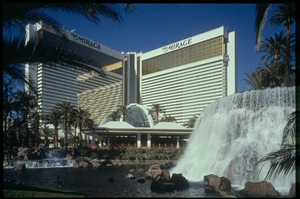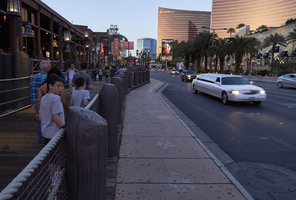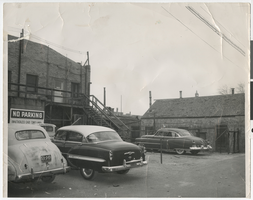Search the Special Collections and Archives Portal
Search Results
1991 Gaming Hall of Fame award ceremony: video
Date
Archival Collection
Description
Moving Image

Myron Martin and Don Snyder interviews, November 30, 2017, December 06, 2017, and March 08, 2018: transcript
Date
Archival Collection
Description
Part 1: Interviewed by Stefani Evans. Myron G. Martin, President and CEO, and Donald D. Snyder, Chairman of the Board of Directors, share their memories of the founding of The Smith Center for the Performing Arts from the first non-for-profit foundation formed in 1996. The second iteration led by Snyder in 1999 brought in Martin--former Director of UNLV Performing Arts Center--and created a sustainable business plan for a center for the performing arts that would be accessible geographically and culturally for all segments of Nevada society. Here, Martin and Snyder recall how land, funding, and legislation for The Smith Center depended on the ""power of the project"" and the Snyder-Martin team's ability to overcome skeptics in the public, the Nevada Legislature, the Clark County Commission, the Las Vegas City Council, and the Don Reynolds Foundation. Martin and Snyder satisfied the various requirements for each organization and earned unanimous approval at each stop--in fact, the $50 million donation to The Smith Center was the largest the Don Reynolds Foundation had ever granted largest. That the approvals came on three consecutive days from competing municipal jurisdictions makes the accomplishment even sweeter. Subjects: Las Vegas, NV; Cultural center; Performing arts; The Smith Center for the Performing Arts; The Smith Center; Not-for-profit;; Nevada Legislature; Clark County Commission; Las Vegas City Council; The Don Reynolds Foundation; Fundraising; Planning; Endowment; Part 2: Interviewed by Stefani Evans. Martin, who was the youngest of three boys raised in suburban Houston, Texas, likes to say that in college at the University of North Texas he played for the Atlanta Braves and the Texas Rangers. So he did--as the organist. He earned a Bachelors of Music in piano, organ, and voice and an MBA from Golden Gate University. He came to Las Vegas after a fifteen-year career with the Baldwin Piano Company as executive director of the Liberace Foundation; he later became president of UNLV?s Performing Arts Center and in 1999 he became president of the Las Vegas Performing Arts Center Foundation. Here, Martin and Snyder recall the process whereby they hired architect David Schwarz of Washington, DC, to create The Smith Center's ""timeless, elegant"" look; creating a ""shared vocabulary"" by visiting 14 performing venues in 5 European countries; the City of Las Vegas's RFP that resulted in hiring Whiting-Turner Contracting Company; the exterior art/artists, significance of the bell tower, Founding Fifty(seven), and the ability of the theater to adapt from staging The Book of Mormon to staging a community funeral for two slain police officers. Subjects: The Smith Center; The Smith Center for the Performing Arts; Architecture; Fundraising; Acoustics; Public private partnerships; Request for proposals; Whiting-Turner; Theater Projects Group; vocabulary; Part 3: Interviewed by Stefani Evans. Author Jack Sheehan, joining this third session on The Smith Center in his role as Don Snyder's biographer, explains the way he envisions the place of The Smith Center in the larger context of Las Vegas. Martin and Snyder provide names for the group that grew out of the Call to Action meeting and founded the original Las Vegas Performing Arts Foundation. They share anecdotes of a 2005 trip, wherein they were joined by Las Vegas City Councilman Lawrence Weekly, City of Las Vegas Mayor Oscar Goodman, and consultant to the City of Las Vegas Dan Van Epp to visit City Place and the Kravis Center for Performing Arts in West Palm Beach as an example of a place where a performing arts center was a catalyst for revitalization in an area of underused and underutilized urban land. They discuss opening night, March 10, 2012, /From Dust To Dreams: Opening Night at the Smith Center For The Performing Arts/, which was produced broadcast live on national Public Broadcasting System (PBS) television stations, produced by George Stevens Jr. and directed and produced by Michael Stevens for The Stevens Company; hosted by Neil Patrick Harris; and featuring Jennifer Hudson, Willie Nelson, Merle Haggard, Emmylou Harris, Martina McBride, Carole King, Arturo Sandoval, Joshua Bell, Mavis Staples, Pat Monahan; American Ballet Theater dancers Marcello Gomes and Luciana Paris; also Broadway performers Brian Stokes Mitchell, Laura Osnes, Cheyenne Jackson, Sherie Rene Scott, Montego Glover, and Benjamin Walker. Martin describes how provisions of Nevada SB235--introduced March 6, 2017, signed into law by Governor Bob Sandoval, and became effective October 1, 2017--for the regulation of ticket sales to an athletic contest or live entertainment event affect The Smith Center ticket sales. They talk of providing 3,600 good construction jobs during the recession, of Discovery Childrens Museum, of future development plans for the entire 61-acre Symphony Park parcel, and of a second capital campaign to increase the endowment to $100 million to enable The Smith Center to be economically sustainable.
Text
New Years Eve firework celebration at the Stardust: video, 2003 February 25
Level of Description
Scope and Contents
Special "Global Noon Hour" segment on Las Vegas, specifically the Stardust Hotel. Begins with the host asking Jim Seagrave (Vice President of Operations) questions about the hotel/casino inside the casino. Seagrave gives some history to the hotel, and talks about how much it has grown and changed. He speaks about the "Lido" being the longest running show until it closed at 1991, and also discusses their location on the Strip being an exciting place to be at the moment with Steve Wynn's new project being constructed. They talk about about new features, including themed slot machines and million-dollar jackpots.The host then speaks with a Stardust dealer who walks through various games, including craps and blackjack. He speaks with a pit boss, who explains what they do and a bit about the Stardust player's club. They visit the Stardust Race and Sports Book, and discuss how it works and which sports are most popular. The next segment the host speaks with the general manager and hosts of William B's, a fine dining establishment. The host speaks with a waiter who has been with the restaurant since 1963, and he shares celebrities who have dined at the restaurant over the years. The final segment of the show takes a look inside some of the hotel's high-roller suites and the amenities that they include. Original media VHS, color, aspect ratio 4 x 3, frame size 720 x 486.
Archival Collection
Collection Name: Stardust Resort and Casino Records
Box/Folder: Digital File 00, Box 049
Archival Component
Schorr, Marc, 1947-
Marc Schorr is the former chief operating officer (COO) of Wynn Resorts, Ltd. in Las Vegas, Nevada. He served as COO of Wynn for thirteen years, until his retirement in 2013. Schorr worked in the casino gaming industry for more than thirty years, and held many senior executive positions at Steve Wynn's former company, Mirage Resorts; Schorr was president and COO of both The Mirage and Treasure Island casinos.
Person

The Mirage Resort: photographic film
Date
Archival Collection
Description
Image

The Mirage volcanoes at night: photographic film
Date
Archival Collection
Description
Image
Joan Adams Shoofey oral history interview
Identifier
Abstract
Oral history interview with Joan Adams Shoofey conducted by Claytee D. White on January 30, 2024 for the Boyer Early Las Vegas Oral History Project. In this interview, Shoofey recalls moving to Las Vegas, Nevada in 1955, where she became Miss Sahara Hotel Casino before becoming Miss Nevada. Born in Fresno, California, Shoofey moved to Tahoe the day following her high school graduation. She and her friend ran the Stateline Country Club for one season and then moved to Las Vegas. Once at the Sahara, she became the Entertainment Coordinator at the Flamingo and then at the International where she worked with Tom Jones.
Archival Collection

Pedestrian traffic on Las Vegas Boulevard, Las Vegas, Nevada: digital photograph
Date
Archival Collection
Description
Image

Photograph of the alley located behind the Elko Rooms, Las Vegas (Nev.), 1952
Date
Archival Collection
Description
Image
Unette and Richard King oral history interviews
Identifier
Abstract
Oral history interviews with Unette and Richard King conducted by Claytee D. White on March 19, 2015 and January 30, 2018 for the Boyer Early Las Vegas Oral History Project. Richard King begins by describing his early upbringing in Canada before moving to the United States, and eventually moving to Nevada in 1940. He talks about living in Whitney, Nevada before moving to the Huntridge area of Las Vegas, Nevada and describing life in the two places during World War II. He also discusses his father's life and career, working for the railroad in Las Vegas, working as a journeyman printer for Pop Squires, and later owning several newspaper publications, which included the Whitney News, Las Vegas Tribune, Hendersonian, Henderson Herald, and North Las Vegas Sun. Unette King describes her upbringing as a Las Vegas native and her father, who was a construction worker for the Hoover Dam (Boulder Dam). Throughout the interviews, the couple discuss Las Vegas history and aspects of life in the city, including the development of casinos, recreation activities, race relations, and how the city has changed. The two conclude the interview by discussing their reaction to the 1 October mass shooting in Las Vegas, how the city came together following the shooting, and accusations of sexual harassment against Steve Wynn.
Archival Collection
